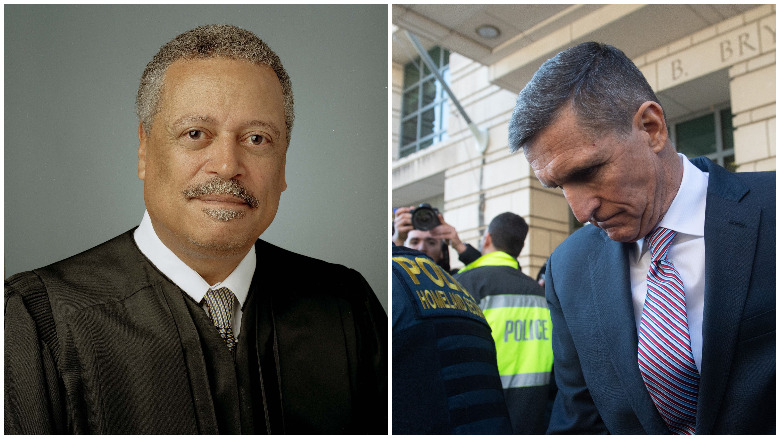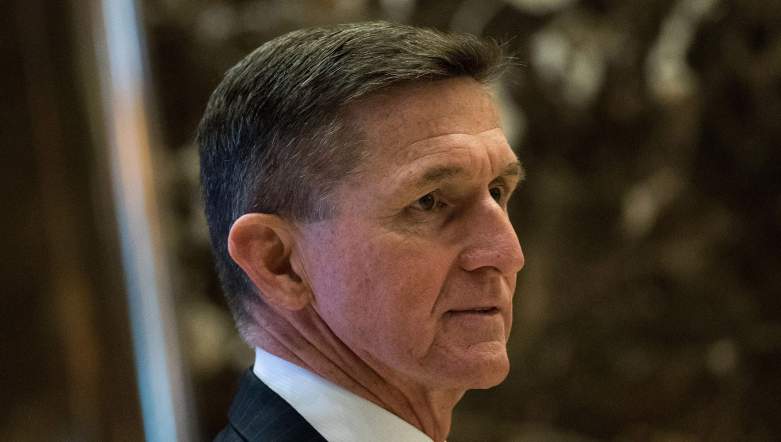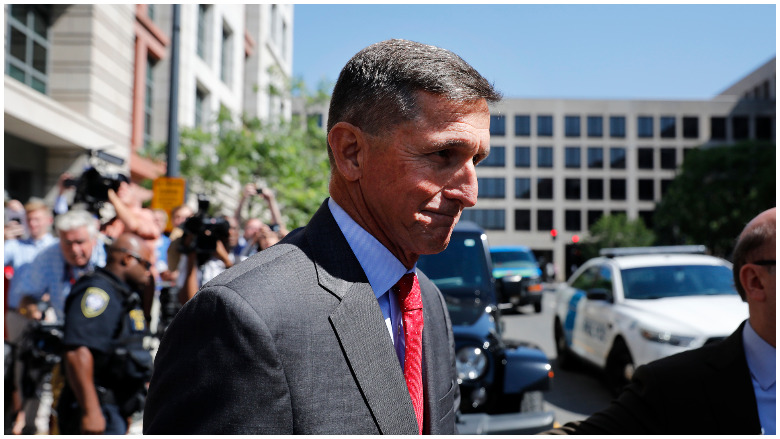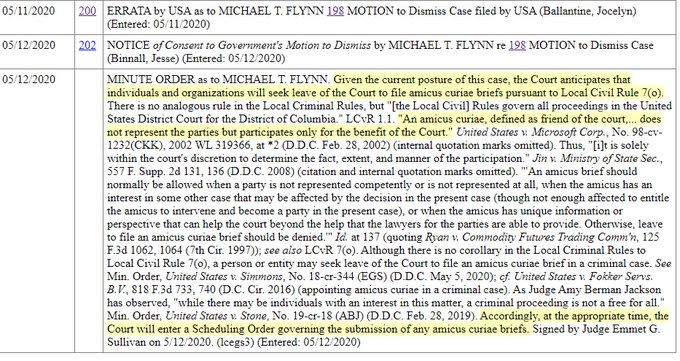
Wikimedia Commons/Getty Federal Judge Emmit Sullivan (r) and Michael Flynn.
Emmet Sullivan, the federal judge presiding over the Michael Flynn case, took several controversial actions after the Department of Justice moved to dismiss its charges against the former national security advisor.
That has some people on both sides of the political aisle wondering: Can a federal judge be removed? More specifically, can a federal judge be removed by President Donald Trump, who has made no secret of his displeasure with the Flynn prosecution?
The answer is that, yes, federal judges can be removed, but it’s a complicated impeachment process that would be a high hurdle to get over, making it exceptionally unlikely. And, no, Trump doesn’t have the power to remove Emmet Sullivan or any federal judge. That power falls to Congress under the U.S. Constitution.
Here’s what you need to know:
Federal Judges Can Be Impeached by the House & Convicted by the Senate

GettyMichael Flynn
Removing a federal judge is similar to the presidential impeachment process. According to the Brennan Center for Justice, Article I of the United States Constitution gave the House of Representatives the power to impeach a federal judge and gave the Senate “the power to hold a trial to determine whether removal is appropriate.”
To impeach a judge requires a majority vote in the House. It takes two-thirds of the U.S. Senate after trial to convict and remove a judge. That would require strong bipartisan support for removal, which is exceptionally unlikely in a politicized case like Flynn’s.
How rare is this? So rare at the federal level that the House has impeached only 15 judges since 1803, and only eight of those judges were convicted by the Senate, according to the Brennan Center. The Center points out that the Constitution is vague on which offenses should trigger removal, citing only “Treason, Bribery, or other high Crimes and Misdemeanors.” Previous impeachment cases against federal judges involved things like sexual assault and bribery. There’s strong precedent not to remove a judge for court rulings, the Brennan Center pointed out.
As the above clearly underscores, the president doesn’t have the power to remove a federal judge. Federal judges are not limited by terms; they serve “during good behavior,” meaning until they retire, die or are removed from office.
Judge Sullivan Referenced ‘Treason’ While Handling the Flynn Case & Named a Retired Judge to Review the Matter

GettyMichael Flynn.
In May 2020, after the U.S. Department of Justice moved to dismiss its case against Flynn, following the recommendation of U.S. Attorney Jeff Jensen, Sullivan delayed the decision on whether to grant dismissal. Instead, he allowed outside parties to submit friend of the court briefs on the case.
The DOJ’s move came after the release of FBI agents’ notes that said things like, “What is our goal — truth, admission or to get him to lie so we can prosecute him or get him fired?” The DOJ found that statements Flynn made to investigators weren’t material to a justified investigation.
The order signaled that the judge won’t immediately rule on whether to dismiss the criminal case against Flynn.
Sullivan then took the unusual step of naming an outsider, a retired judge, John Gleeson, to examine the Flynn case, including whether Flynn might have committed perjury because of his guilty plea.
The judge also made controversial comments on Flynn and treason.
In 2018, when Flynn came before Sullivan for a sentencing that was ultimately postponed, the judge said, “I am going to be frank with you, this crime is very serious. I can’t hide my disgust, my disdain, at this criminal offense.” At that hearing, Sullivan also asked prosecutors whether they had considered charging Flynn with treason. The judge then tried to clarify, saying, “I wasn’t suggesting he was committing treason. I was just curious if he could have been charged. Lots of conspiracy theories out there. Not taking any uncalled offenses into consideration. Was trying to consider benefit. I’m not suggesting treason.”
Sullivan’s Order on Friend of Court Briefs Was Immediately Controversial
Sullivan’s order allowing friend of court briefs was immediately critiqued. Supporters of Flynn derided it. The briefs are technically called “amicus curiae,” and they allow outside parties to legally weigh in.
Sean Davis, a conservative with the Federalist, wrote on Twitter, “Judge Emmet G. Sullivan just signaled he’s not interested in the law, due process, equal rights, or justice. He already called Flynn a traitor in open court, and now he’s going to invite left-wing lawyers write his final order against Flynn for him.”
Sidney Powell, Flynn’s attorney, wrote: “The proposed amicus brief has no place in this Court. No further delay should be tolerated or any further expense caused to him and his defense.”
Others have criticized the DOJ’s handling of the case.
Neal Katyal and Joshua Geltzer, two Georgetown Law professors critical of the DOJ’s decision on Flynn, wrote an opinion piece in the New York Times on May 8 that noted that the court’s approval is needed to drop a prosecution. They wrote that Judge Sullivan had several options, among them:
First, he can examine why the highly regarded former prosecutor of Mr. Flynn withdrew from the case moments before the Justice Department’s astonishing filing. Last year, after the Supreme Court essentially held that the Trump administration had lied about the census and several Justice Department attorneys attempted to withdraw from the case, the presiding federal judge refused and began an inquiry into the attorneys’ withdrawal. A similar inquiry is appropriate here.
Sullivan has been named to judicial positions by three presidents, one a Democrat and two Republicans.
Sullivan was named to the federal bench by former President Bill Clinton.
According to Ballotpedia, “Sullivan was nominated by President Bill Clinton to the United States District Court for the District of Columbia on March 22, 1994, to a seat vacated by Louis Oberdorfer.” Ballotpedia lists former Vice President Joe Biden, then a U.S. Senator, as being among Sullivan’s supporters at that time. According to Sullivan’s federal judicial bio, the judge was “confirmed by the Senate on June 15, 1994, and received commission on June 16, 1994.”
Sullivan also served as a judge in the Superior Court of the District of Columbia from 1984 to 1992, appointed by former President Ronald Reagan.
“As an Associate Judge of the Superior Court, Judge Sullivan was one of only seven judges in the twenty-four year history of that court to have served full-time in every division. He served as the Deputy Presiding Judge and Presiding Judge of the Probate and Tax Divisions, as well as chairperson of the Rules Committee for those divisions,” his court bio reads.
On November 25, 1991, Sullivan “was appointed by President George H. W. Bush to serve as an Associate Judge of the District of Columbia Court of Appeals. While an Associate Judge of that court, and in addition to his full-time case management responsibilities, Judge Sullivan was Chairperson for the Nineteenth Annual Judicial Conference of the District of Columbia, which was held in 1994.”
According to his judicial biography:
Judge Emmet G. Sullivan was born in Washington, D.C., and attended public schools in the District of Columbia until his graduation from McKinley High School in 1964. In 1968, he received a Bachelor of Arts Degree in Political Science from Howard University and, in 1971, a Juris Doctor Degree from the Howard University School of Law. Upon graduation from law school, Judge Sullivan was the recipient of a Reginald Heber Smith Fellowship.
Sullivan earned a bachelor’s degree from Howard University in 1968. That’s also where he received his law degree in 1971.
The judge has handled high-profile cases before. Sullivan tossed the conviction of a prominent Republican senator after accusations of prosecutorial misconduct.
READ NEXT: See Photos of the Real Characters Behind Narcos: Mexico
